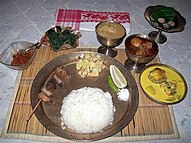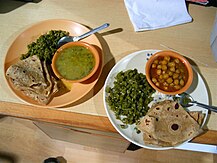Cuisine
Indian cuisine consists of a wide variety of regional and traditional cuisines. Given the range of diversity in soil type, climate, culture, ethnic groups, and occupations, these cuisines vary substantially from each other, using locally available spices, herbs, vegetables, and fruit. Indian foodways have been influenced by religion, in particular Hindu cultural choices and traditions.[442] They have been also shaped by Islamic rule, particularly that of the Mughals, by the arrival of the Portuguese on India's southwestern shores, and by British rule. These three influences are reflected, respectively, in the dishes of pilaf and biryani; the vindaloo; and the tiffin and the Railway mutton curry.[443] Earlier, the Columbian exchange had brought the potato, the tomato, maize, peanuts, cashew nuts, pineapples, guavas, and most notably, chilli peppers, to India. Each became staples of use.[444] In turn, the spice trade between India and Europe was a catalyst for Europe's Age of Discovery.[445]
The cereals grown in India, their choice, times, and regions of planting, correspond strongly to the timing of India's.






No comments:
Post a Comment